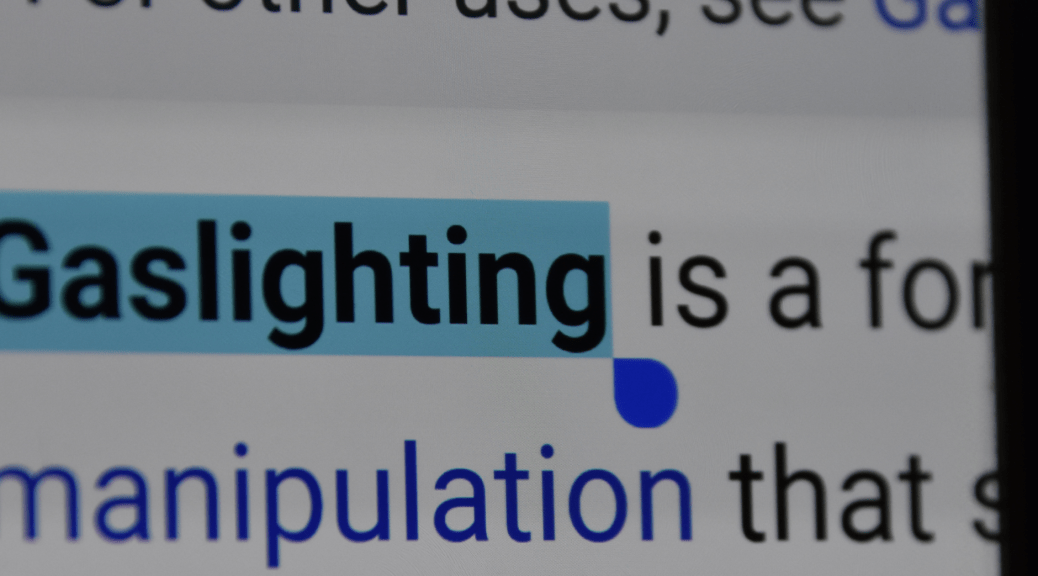
Standing Firm in an Era of Public Gaslighting
The further things move along, the more intense they get out there. The religio-political gaslighting from the right wing is particularly intense right now, so I wanted to offer a quick post talking about what that looks like and offering some techniques for reasonable folks to stand firm in these challenging times.
About Me
As a reminder, I’m approaching this topic as a communication scholar who teaches interpersonal communication and has emphases in rhetoric and mediated communication. My research focus is on stress, trauma, and conflict communication, and my field has spent a lot of time analyzing unhealthy religio-political dynamics. I’m thankful to have benefitted from that.
So yeah, as someone who has looked really closely at how unhealthy communication and persuasion works in both the public and interpersonal spheres, I can tell you (as have other experts, and as I’ve said here before) that we’re dealing with an extraordinary amount of religio-political gaslighting in this particular era. (I’ve talked about gaslighting previously in these articles on this blog.)
What Is Gaslighting?
Gaslighting as a term has been getting a lot of play in recent years because it accurately describes what’s going on. It’s a term that comes from the study of unhealthy relationships and domestic abuse, and yet it applies incredibly well to what also happens in unhealthy religio-political rhetoric, including fascistic rhetoric.
In short, gaslighting describes a pattern of communication that denies a person’s evidence-based knowledge of the world. The movie, Gaslight, that the term’s name is based on specifically shows an intentional example of this kind of rhetoric.
Gaslighting Can Be Intentional or Unintentional
But in reality, gaslighting can fall along a continuum from intentional to unintentional.
How Splaining Can Be Gaslighting
In fact, where we have little knowledge, it is easy to unintionally gaslight people who have more knowledge or expertise of a particular area, either by explaining things they already know or by telling them that what they know to be true is actually false.
This is what’s often referred to as splaining, and it cames in all sorts of varieties—mansplaining and whitesplaining being the most popularly applied.
In this form of gaslighting, someone who is feeling a visceral threat to their ego or position in the societal hierarchy reacts strongly to someone (often someone who is perceived to be societally lower in the hierarchy) having more expertise than them.
The result has nothing to do with rational explanations for things, but everything to do with people reacting to felt threat by those who know more and seek to have that expertise valued, and seeking to gain or maintain status by how they communicate in a situation.
How This Applies to Other Types of Gaslighting
This matters because what’s happening in splaining is also often the visceral motive for all types of gaslighting, whether in the religio-political world or not. This is important.
Let me say that again: In the religio-political world as in the world of domestic abuse, gaslighting most often occurs because the person viscerally feels the other person is seeking equality and/or a higher status. It is not a rational activity—it comes out of stress responses.
It’s Often More Intentional Than You Think
This doesn’t mean people can’t control their gaslighting–in fact, people can control such responses, and Lundy Bancroft’s therapy work with domestic abusers (recorded in his powerful book Why Does He Do That?) shows that in many cases, abuse is more often conscious and intentional than we give abusers credit for.
(In fact, part of the gaslighting is often getting victims and opponents to believe it’s happening fully unconsciously. This leads to a convenient for the abuser assumption that the abuser is a victim unable to stop their abusive patterns. That’s rarely true.)
In short, gaslighting emerges from felt threat. That does NOT mean that gaslighters can’t control their actions.
Gaslighting=Zero-Sum Visions of the World
So the practice of gaslighting is based on felt threat. It’s also based on a depressingly zero-sum vision of the world.
In other words, in this view of reality, if one person “wins,” or “is right,” that means the other person or group automatically “loses” (and the corollary is that being wrong is automatically a loss).
What Gaslighting Is All About
In short, the view behind gaslighting, whether someone means to do it or not, is too often all about status and dominance, coercion and control. This status and dominance comes at the expense, often, of practicality, of rationality, and of the common good.
At best, the more unintentional varieties of gaslighting are about protecting one’s own flight response from reality at the expense of the truth. (That’s natural, but not generally a good look on people, and is often counterproductive.)
So Yeah, Gaslighting Is Unhealthy—How Does It Work?
Gaslighting is considered a form of abuse because it seeks to dominate another person’s first-order realities. As I’ve described before, communication scholars define first-order realities as observable facts. Second-order realities, on the other hand, involve our attaching interpretations to those first-order realities.
Gaslighting can work a lot of ways, but it often tends to either deny first-order realities. Or it works to twist them into saying that some first-order realities are accurate, but only if you deny others in order to buy into a set of second-order realities the gaslighter is peddling.
As I described in my rhetoric of conspiracy series, conspiracy rhetoric does this. That’s why unhealthy leaders often elevate the rhetoric of conspiracy. We’ve certainly been seeing from the right strongly these days.
Fascistic Rhetoric and Types of Gaslighting
As I’ve said before, a couple of the most common forms of gaslighting rhetoric in fascistic rhetoric both relate to false equivalency. These include whataboutism and bothsidesism.
So what is a false equivalency? It’s assuming that two things that look alike on the surface are the same. In both the worlds of domestic abuse and of fascistic rhetoric, the idea is often to promote the idea that the abusive gaslighter is not being a bully because the person on the other side is just as bad or worse.
In the whataboutism, the abuser seeks to wriggle out of responsibility for something. They often do this by insisting that someone else (usually an enemy or victim) started it or did something worse. In bothsidesism, the person insists that both sides do the “same thing.” This, again, is a way to wriggle out of responsibility.
Particularly Toxic when Religion and Spirituality Become Wrapped In
And let’s be honest—it just gets worse when things like theological concepts and verses from sacred texts and appeals to “what a deity wants” become part of this picture.
When God and morality are used to gain status and security and to control rather than out of collaboration and love and to take care of the vulnerable? That gets d*mned ugly and spiritually abusive.
Interpreting the Golden Rule Healthily
Every religion has a version of the Golden Rule. And it’s important to realize that “do unto others as you would have them do unto you” doesn’t mean we need to practice bothsidesism.
In fact, as I’ve described many times before, healthy spirituality is that in which love must include calls for healthy accountability, especially in situations of abuse and gaslighting.
The common good often requires some people to be right and others to be wrong. That’s okay. That’s healthy. What’s unhealthy is when people’s need to be right and to control and to dominate becomes more important than taking care of the common good.
So How Can We Stand Firm in Response to This Toxic Crap?
Okay, so some quick tips for continuing to stand firm in the midst of all the unhealthy gaslighting going on these days:
- Look for and separate first-order realities from second-order realities. Insist on the reality of first-order realities. Acknowledge the limits of second-order realities wherever it makes sense.
- Look for and insist on adding to the conversation other first-order realities that add nuance to the conversation.
- Offer reality-checking support and reassurance to those around you. That should include regular confirmations that the first-order realities are true, and that reasonable second-order realities are supported by the first-order data. (This helps all of us who are resisting gaslighting stand firm while leaving room for reasonable disagreements by those who all recognize the same first-order realities.)
- Look for genuine experts—both those with on-the-ground experience and those studying and researching and practicing a certain area—as guides when it comes to second-order realities. Recognize that because they’re working in second-order realities, their interpretations will be limited—but that doesn’t mean they don’t have good info to go on. Don’t let gaslighters diminish expert conclusions without good reason.
- Don’t play by the gaslighter’s playbook. (Also, don’t accept their likely demonization of you for drawing attention to their garbage.)
- Judge your own energy levels in speaking up against gaslighting. Sometimes drawing attention to the first-order facts of unhealthy rhetoric as you are walking away is the best move for a given situation. Engage in as much self-care as you need to. And remember this is a relay marathon. Come back when you’re able.
- And, of course, look for and check yourself if you find yourself following gaslighter patterns–but look at the data to make sure that’s happening before you trust the other person’s judgment. You can look at the above definitions (and of course cross-check them with other expert definitions of gaslighting–mine aren’t necessarily the best, and don’t need to be) for help in prising that out.
Why Public Gaslighting Is Harder to Pull Off—and Why It’s So Dangerous
Overall, the weird disadvantage of when gaslighting occurs on a public stage as opposed to a domestic one is that it’s often harder to get everyone on board.
The problem, of course, is that the reason it often works is that everyone is vulnerable to stress responses and the unhealthy forms of status conflict that can emerge.
And if you can convince a large group of people that the gaslighting is correct and that the oppositional group is not just wrong but an untrustworthy source of information (and morally suspect as well), it’s just possible at times for the gaslighters in charge to gain and maintain enough power to pull off their power play.
Why We Need to Keep Standing Up
The truth, of course, is that religio-political gaslighting ought not be underestimated, but it ought not be overestimated either.
The current gaslighters in charge are relying on the perception that what they do will work. They rely on the exhaustion of the opposition in order for their power plays to work and keep working.
THIS is why we need to keep supporting one another and speaking up assertively against the unhealthy rhetoric and policies. It’s crucial to keep going in this relay marathon the best we can, toward the common good.
A Final Charge
Go team #AssertiveSpirituality! Let’s continue to do what we can where we are with what we’ve got. We can do this thing.
Looking for more resources toward speaking up for what’s right and dealing with the conflict that results?
Boy, do we have got a free “Assertive Spirituality Guide to Online Trolls” for you. It actually helps you with conflict both online and off. To get it, sign up for our email newsletter (either in the top bar or by checking the appropriate box when commenting on this article). Once you’ve confirmed your email address, we’ll send you the link to the guide in your final welcome email. You can unsubscribe at any time, but we hope you’ll stick around for our weekly email updates. This summer we’re hoping to offer more online courses and other support resources for those advocating for the common good, and if you stay subscribed, you’ll be the first to know about these types of things when they pop up.


4 thoughts on “Standing Firm in an Era of Public Gaslighting”
Hi – I’ve been on your mailing list for a while but never got any link for the “Assertive Guide to Online Trolls.” I would like to have that if possible. Thanks. I really enjoy your newsletters. All very important info right now.
I’m glad to hear you’ve been finding the work meaningful and helpful, Bernie! Same as with Rachel above, you should have received the link to that just after your subscription came through. If you continue to have trouble finding it, please message me at our inbox at FB.me/AssertiveSpirituality and I’ll do my best to get it to you as soon as I dig out from my midterm-grading swamp. Thanks much!
I have asked for the paper on online trolls. Please send it to me.
Hi Rachel! It should have come in your final welcome email, if you finished signing up for the email newsletter. Get in touch through our messaging feature at FB.me/AssertiveSpirituality if you’ve continued to have trouble finding it. Apologies for my delay on this–this is a side project and I’m teaching university classes online because of the pandemic and I’ve been swallowed up in grading midterms.